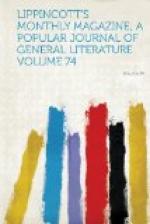Joseph Noirel’s Revenge. By Victor Cherbuliez. Translated from the French by Wm. F. West, A.M. New York: Holt & Williams.
M. Victor Cherbuliez belongs to a Genevese family long and honorably connected with literature in the capacity of publishers both at Paris and Geneva. It is in the latter town and the adjacent region that the scene of the present story—the first, we believe, of the author’s works which has found its way into English—is laid; and much of its charm is derived from the local coloring with which many of the characters and incidents are invested. Even the quiet home-life of so beautiful and renowned a place cannot but be tinted by reflections from the incomparable beauties of its surroundings, and from the grand and vivid passages of its singularly picturesque history. The subordinate figures on the canvas have accordingly an interest greater than what arises from their commonplace individualities and their meagre part in the action—like barndoor fowls pecking and clucking beside larger bipeds in a walled yard steeped in sunlight. But the sunlight which gives a delicious warmth and brightness to the earlier chapters of the novel is soon succeeded by gloom and tempest. The interest is more and more concentrated on the few principal persons; and the action, which at the outset promised to be light and amusing, with merely so much of tenderness and pathos as may belong to the higher comedy, becomes by degrees deeply tragical, and ends in a catastrophe which is saved from being horrible and revolting only by the shadows that forecast and the softening strains that attend it. In point of construction and skillful handling the story is as effective as French art alone could have made it, while it has an under-meaning rendered all the more suggestive by being left to find its way into the reader’s reflections without any obvious prompting. The heroine, sole child




